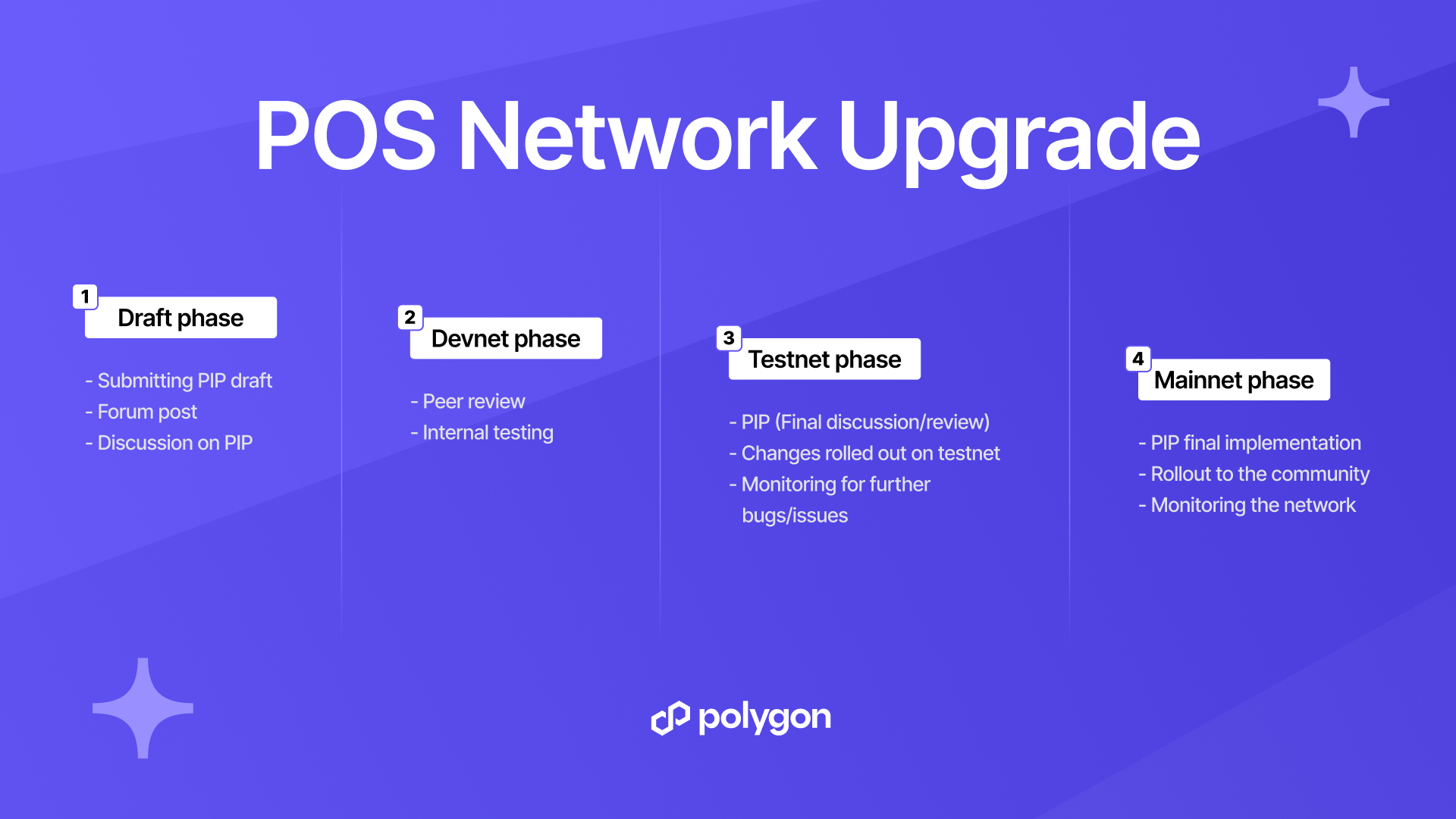Network upgrade process
Network upgrade overview¶
This page provides hardfork activation timestamps along with links to detailed specifications. It also outlines the hardfork release process, versions, network and node i.,e bor/heimdall. The network upgrade naming scheme follows the order in which the release happened on the Polygon network.
Activations¶
On the Polygon Network, upgrades are activated based on timestamps. If you fail to update your Polygon client software before the specified timestamp, it may result in chain divergence, requiring a full resynchronization.
| Upgrade | Forum | PIP | Activation |
|---|---|---|---|
| Delhi Hardfork | Link | PIP-7 | Block >= 38,189,056 on Polygon Mainnet (Bor) |
| Indore Hard Fork | Link | PIP-13 | Block >= 44,934,656 on Polygon Mainnet(Bor) |
| Aalborg Hard Fork | Link | PIP-21 | Block >= 15,950,759 on Polygon Mainnet (Heimdall) |
| Agra Hard Fork | Link | PIP-28 | Block >= 50,523,000 on Polygon Mainnet (Bor) |
Block >= 41,874,000 on Polygon Mumbai (Bor) |
|||
| Napoli Hardfork | Link | PIP-33 | Block >= 54,876,000 on Polygon Mainnet (Bor) |
Block >= 5,423,600 on Polygon Amoy (Bor) |
|||
| Ahmedabad Hardfork | Link | PIP-37 | Block >= 62,278,656 on Polygon Mainnet (Bor) |
Block >= 11,865,856 on Polygon Amoy (Bor) |
|||
| Jorvik Hardfork | Link | PIP-53 | Block >= 22,393,043 on Polygon Mainnet (Heimdall) |
Block >= 5,768,528 on Polygon Amoy (Heimdall) |
|||
| Danelaw Hardfork | Link | PIP-56 | Block >= 22,393,043 on Polygon Mainnet (Heimdall) |
Block >= 6,490,424 on Polygon Amoy (Heimdall) |
|||
| Bhilai Hardfork | Link | PIP-63 | Block >= 22,765,056 on Polygon Amoy (Bor) |
Upgrade process¶
Network upgrades follow this general process in which the features included in the upgrade are put into a release version cut from the develop branch and then the software is deployed on production networks.

1. Proposal & Governance Approval¶
Polygon is governed by the polygon governance, where any significant protocol changes, including hardforks, must be proposed and approved through a governance and community discussion on forum. The process includes:
- Submitting an Polygon Improvement Proposal (PIP).
- Community discussion and feedback.
- On-chain voting to pass the proposal.
2. Development & Testing¶
Once a proposal is approved, developers implement and test the changes:
- Code is developed and reviewed.
- Extensive testing is conducted on Devnets and testnets to ensure security and stability.
- Smart contracts and Layer 2 infrastructure are upgraded.
3. Node & Software Upgrades¶
Once the development is done, announcement is done for validators and node operators.
- Node operators and validators must update their software before the hardfork activation timestamp.
- Failure to upgrade could result in a chain split or desynchronization.
4. Hardfork Activation¶
- The upgrade is scheduled at a specific block height or timestamp.
- If all nodes update in time, the upgrade is seamless.
- If some nodes fail to update, they risk being left on an outdated chain.
5. Post-Hardfork Monitoring¶
- After activation, the network is monitored for stability.
- Any bugs or issues are addressed quickly through patches if needed.